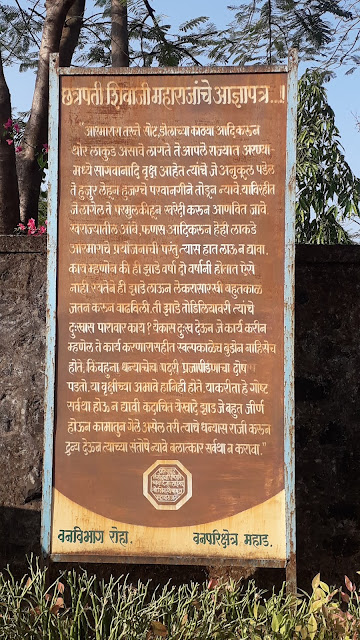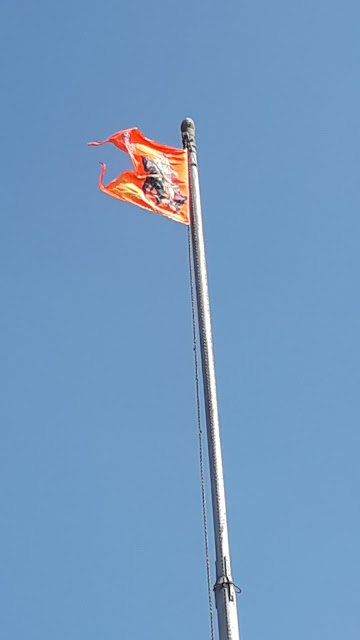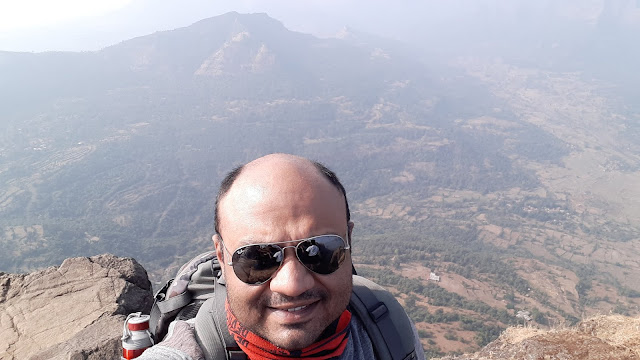 |
| Throne of Shivaji Maharaj |
It had been almost a year now, that I had done any trek. Extended rains in Maharashtra had
disrupted most of the trek plans. So early into January 2020, Sneha called from work one day and
informed that her colleagues are planning a one day trek. I was excited and
asked her where they were planning to trek. She replied "Raigad". I
instantly said yes, as I had never been to fort Raigad. The one day trek was
planned for Sunday 5th January 2020.
Raigad
is a hill fort located 132kms from Pune. The nearest town to fort Raigad is Mahad.
Fort Raigad was constructed by Raje Chandrojirao More of Jawali. They were the
descendants of the Great Chandra Gupta Maurya family. The fort Raigad was also
known by other names in various eras by – Rairi, Gibraltar of the East,
Islamgad, Rairigad, Shivlanka etc.
Raigad
was captured by Chttarapati Shivaji Maharaj and made the capital of the Maratha
Empire in 1674. Coronation of Shivaji Maharaj also took place on this fort.
Later Sambhaji Maharaj’s thread ceremony too happened on this fort. Raigad was
strategically located in the Sahyadris equally distant from the Deccan
Plateau and the Sea. This was later captured by the British in 1818,
looted and then destroyed.
The Beginning
We
began at 4.30AM from Chinchwad in a 17 seater vehicle along with 12 of Sneha’s colleagues.
It was going to take us 4 hours to reach the base village Raigadwadi and Pachad along with a halt for breakfast at Tasgaon. We traveled via the Tahmini Ghat route. While
travelling we discussed about various events in the life of Shivaji Maharaj and
how he has been an inspiration for generations now and for generations to come.
At around 8AM we halted at Tasgaon for breakfast and moved
towards Pachadgaon which was 35kms.
 |
| Travelling towards Pachadgaon |
At Pachadgaon
At the
entrance of Pachadgaon who will get to see the Samadhi of Rajmata Jijau. She was
the mother of Chhatrapati Shivaji Maharaj. Earlier this Samadhi was in ruins
but was restored by few servicemen whose plagues mention the same.
 |
| Plaque outside the Rajmata Jijau Samadhi - Pachadgaon |
 |
| Rajmata Jijau Samadhi |
 |
| Re-built Rajmata Jijau Samadhi |
We took
some pictures with the trek team and then left for the base of Raigad fort.
 |
| Trek team for the day |
At Raigadwadi Steps
The
approach to the forts base is well connected via road. To reach Raigad fort one can
climb via steps (2000+) or take the rope-way. The rope-way will take you to the South
side of the fort in 15 minutes, while it will take you 2 hours to reach via the steps
towards the West side of the fort through the Maha Dwar (Main entrance).
 |
| View from base of Raigad Steps |
 |
| Raigad - West View |
Climbing towards Raigad
We
began climbing via the steps at around 10.30AM and the initial few minutes were
difficult to climb due to the steps. We had constant breaks as for
all it was not possible to climb at one go. The climate while climbing was
pleasant with a gentle cold breeze. Since it was a Sunday, there were huge
crowds of school children, college students, trek enthusiasts and families who
came from near and far across Maharashtra.
 |
| Climbing via steps route near Pachadgaon |
 |
| First Remains of outer protective wall of the fort |
 |
| Shorter Route from the base of steps |
 |
| Breather while on the step routes |
 |
| Followers Groups |
After climbing one-fourth of the steps we came up to a traverse which leads towards
the main entrance of the fort. While on the way, we could clearly see the Tak Mak Tok site which was used as a location for punishment. Traitors & criminals were put in a sack and thrown into the valley. Tak Mak Tok has been mentioned in various history books. With this you can also see the inner bastions of the fort which run along the entire perimeter of the fort. I clicked some pictures while walking along the traverse.
 |
| While walking along the traverse leading towards the main entrance |
The traverse is well hidden from the main entrance with lots of turns and twists on the way.
The
path leading towards the main entrance turns and twists its way climbing continuously. It is
strategically inclined to tire anyone trying to attack the fort. The Maha Darwaja had sharp spikes so that no animals like an elephant can be used in the attack to force open the door easily.
 |
| Bastions of main entrance |
 |
| Much clearer view of the inner bastions and protective wall |
The entrance to the fort is narrow and turns right. At the fort entrance, we have to pay an entry fee of INR 25 for all Indian visitors. For foreigners, the entrance fee is INR 300 and if you intend to shoot on the fort, you have to pay INR 1000.
 |
| Main Entrance to the fort - Maha Dwar |
After
you enter through the main entrance the way is narrow and then opens up into
the fort.
 |
| Narrow way after the Main Entrance |
After you go past the narrow passage, you will find a map of the fort that denotes the various locations on the fort which can be visited. Overall there are 45 locations which can be explored.
 |
| Fort map showcasing various locations |
The entrance from the top looks interesting as whenever any opposing army would have made it till here, they would have suffered losses.
 |
| Entrance from the top |
Inside the fort
This is a large fort which is spread around 1,300 acres. All important structures and locations lay in the middle of the fort. We had to climb another 300 to 400 steps to get to the main building area of the fort. On the way you can see some ancient structures and armory.
 |
| An ancient cannon |
 |
| Ancient Cannon - This is how it would have been used to aim |
As we climbed the 300-400 steps, we witnessed a large tank in the middle which is known as the Hatti Talav (Elephant Tank). Since this fort was the capital fort of the Maratha Empire, it housed a large number of people. With that in mind the architect of the fort Hiroji Indalkar had created these enormous tanks that harvested rain water all the year around.
 |
| Hatti Talav from top |
 |
| Depth of the tank could be around 40-50 feet |
At this location we decided to take a guided tour around the fort to visit some important locations. We then walked toward the Gangasagar Talav (Gangasagar Tank). This tank historians say was filled with waters of major rivers of India for the coronation ceremony of Shivaji Maharaj. This tank can also hold a large amount of water throughout the year.
 |
| Hatti Talav Tank |
 |
| Gangasagar tank from top view |
After a brief history session by the guide, we then moved towards the upper deck of the fort which housed the forts main building which was used by Shivaji Maharaj and then Sambhaji Maharaj. At every important location on the fort, the guide would shout out loud "Shivaji Maharaj ki Jai, Sambhaji Maharaj ki Jai" and we joined in after him.
Fort Main Buildings
After clicking pics we then moved to the main building where we were able to witness the remains of 3 watch towers. These watch towers were earlier 7 storey high, but during the attack of the East India Company, it was reduced to 3 storey. It is said that after Raigad fell into Mughal hands, it burned for 7 days as the entire main building was made of wooden architecture.
 |
| Watch Tower Remains |
We then moved to the entrance of the main building which once housed important people of the Maratha Empire.
 |
| Entrance to the main courtyard |
As we walked through the main entrance and climbed the steps, we came across the remains of the main courtyard building. This housed Shivaji Maharaj and his wives. The main courtyard had 6 rooms for his 8 wives namely Saeebai, Soyarabai,Putalabai,Sakvarbai,Sagunabai,Kashibai,Laxmibai and Gunwantabai. The Queens bedrooms were constructed in 3 parts. First part was the present day living rooms where they greeted family members and guests. The second part were the bedrooms and the third part was kitchens and rest rooms. Opposite the queens bedrooms were the rooms of the helpers for the queens. The walls of the chambers were 12-13 feet high, closed on three sides and had a large window at the back of the bedroom for fresh air.
 |
| Queens Bedrooms |
 |
| Sneha at Queens room |
 |
| Door leading towards the Queens bedroom |
 |
| Plaque showcasing the Queens bedrooms |
Opposite the queens chambers were the offices of the Maratha empire ministries. Raigad was the capital of the Maratha empire and all affairs of the Maratha state were run from these offices.
 |
| Chambers of Ministers |
 |
| More than sixteen chambers of ministers |
The sun was beating down hard on us and we were tired. To quench our thirst we saw ourselves followed by ladies who carry buttermilk and yogurt with them and keep nagging you to try some. I thought of giving it a try and asked one such seller for a glass of curd. Sneha to wanted one. So the lady made us a couple of fresh buttermilk shots.
 |
| Fresh Buttermilk being made |
Since chambers of ministers was close-by, sometimes there was a need to have have secret discussions. Keeping that in mind, the architect had build a secret chamber for discussions.
 |
| Chamber of Secret Discussions |
Beside the Queens bedroom lay the chamber of Shivaji Maharaj, rectangular in shape and the biggest chamber around. These were the chambers which once witnessed Shivaji Maharaj spending most of his time in flesh and blood ruling the Maratha Empire.
 |
| Shivaji Maharaj's personal chambers |
 |
| Frontal View of Shivaji Maharaj's chambers |
 |
| Easy Access to Watch towers from the Kings Courtyard |
As we moved ahead and through the courtyard we come across Nagarkhana Darwaja, which is the hall where the coronation of Chhtarapati Shivaji Maharaj took place twice. This enclosure had been acoustically designed to aid hearing from the dooreay to the throne. The convoy of Shivaji Maharaj and him used the Palkhi Darwaja.
 |
| Statue of Shivaji Maharaj where it is said that his coronation took place |
 |
| Maha Darwaja leading into the Coronation Hall |
 |
| Flagpost near the coronation hall |
 |
| View of the throne from Maha Darwaja leading into Coronation Hall |
 |
| Team |
We then walked towards the marketplace of the fort. As mentioned earlier the fort housed a large number of people, there was a need for food and supplies. A marketplace was constructed near the Nagarkhana. The road leading into the marketplace can fit enormous trucks of todays present day. This was the design genius in the architecture of such places. Each marketplace block had 3 parts to it. The front part must have been used for selling goods, the middle one for storing goods and the third part as residence for the seller. In those days traders used to stay for business for more than 6 months hence needed a place.
 |
| The marketplace of the fort |
 |
| Marketplace with some fine stone designs |
 |
| The marketplace shops designed with 3 compartments |
 |
| The bazaar main road going through the marketplace |
 |
| Me and Sneha walking through the marketplace |
As we went past the marketplace we lead towards the Jagdishwara temple. Shivaji Maharaj and Sambhaji Maharaj believed in divine blessings and interventions.
 |
| Marker showcasing the spots |
 |
| Lord Jagdishwara Temple |
 |
| Frontal view of Jagdishwara Temple |
 |
| Jagdishwara Temple from outside the protective wall |
Behind the Jagdishwara temple is the Samadhi of Shivaji Maharaj. This is the place where his funeral pyre was lit and he traveled to the heavenly abode. Beside the Samadhi of Shivaji Maharaj is the Samadhi of his beloved dog Waghya.
 |
| Samadhi of Shivaji Maharaj |
 |
| Samadhi of Waghya |
 |
| Prasado Jagdishwarasya |
Hiroji Indalkar who was the architect of the fort was asked as to how would he be remembered for constructing such a large fort and they replied saying he would like to have a step named after him which would be as the base step at the entrance of the Jadishwara temple and the door leading towards the Shivaji Maharaj's Samadhi.
 |
| Step mentioning the name of Hiroji Indalkar the architect of the fort |
After spending some time at the Samadhi we moved towards the Tak Mak Tok from where criminals were punished by pushing them over into the valley.
 |
| Way leading towards Tak Mak Tok |
Tak Mak Tok looks very similar to Vinchu Kada on Lohagad near Lonavala. The valley from this point is 800 feet.
 |
| View from Tak Mak Tok |
 |
| Close to the safety railing |
 |
| An apt flag fluttering |
 |
| Me at Tak Mak Tok |
 |
| Sneha at Tak Mak Tok |
 |
| View from Tak Mak tok |
After visiting the Tak Mak Tok directly had our late lunch as its was already 4.30 PM. We had ordered food from villagers staying on the fort. It was a simple meal of rice bhakari and pithla with some spicy masala.
 |
| Team settled for the simple lunch |
 |
| Tired and ready for the meal |
 |
| Beside the home of our Anaadata- A village home |
 |
| Simple yet tasting meal |
As others were having their meals I finished early and excused myself to explore a site nearby the villagers home. This site was known as Brahmanwada which housed the temple priests of the Jagdishwara temple. There I found an ancient bolt fixed on the structure which would have been used for tying ropes.
 |
| The Ring Bolted on a structure of Brahmanwada |
 |
| View of the marketplace structure near Brahmanwada |
After spending time freshening up we started our descend towards the base at 5.15 PM. It took us 1 hour to reach the base as the descend is much faster. While descending, monkeys visited us on the way who were looking for a easy meal before the Sun down.
 |
| At the main entrance of the fort |
 |
| Time to take a pic with the team with less crowd |
 |
| Looking for a quick bite before Sun down |
So after 14 hours, the Sun finally set on the day and we were able to witness the Sunset. It was an interesting day filled with lots of activity. Enjoyed every moment of this trek. Now, leaving you with some pics of the Sunset. Until next time and another trek story, Ciao.
 |
| Sunset |
Things to keep in mind:
1) Start early if you intend to visit various locations on the fort.
2) Carry enough water and some fresh snacks like fruits.
3) Be prepared for long walks as some locations on the fort are ways apart.
4) Have good footwear and easy clothes which are stretchable.
5) Take photographs carefully and with dignity as the fort is a sacred place.
6) Enjoy your trek and spend time exploring rather than just clicking pictures.
7) Keep the fort surroundings clean and carry your garbage with yourself.























































































